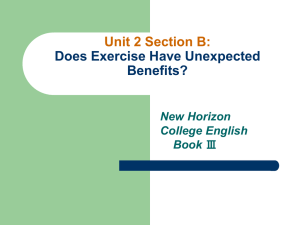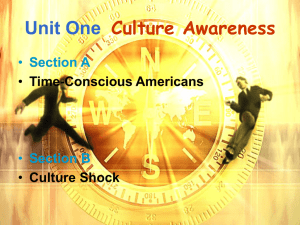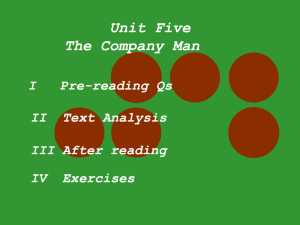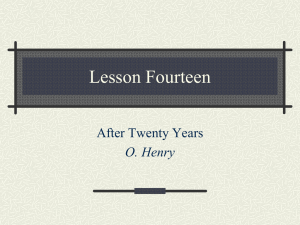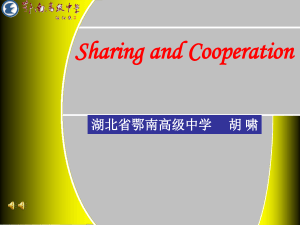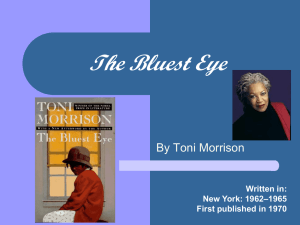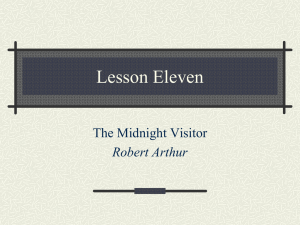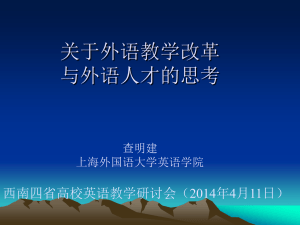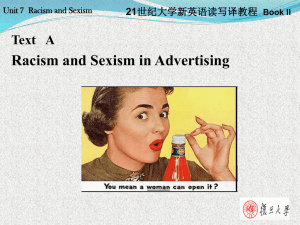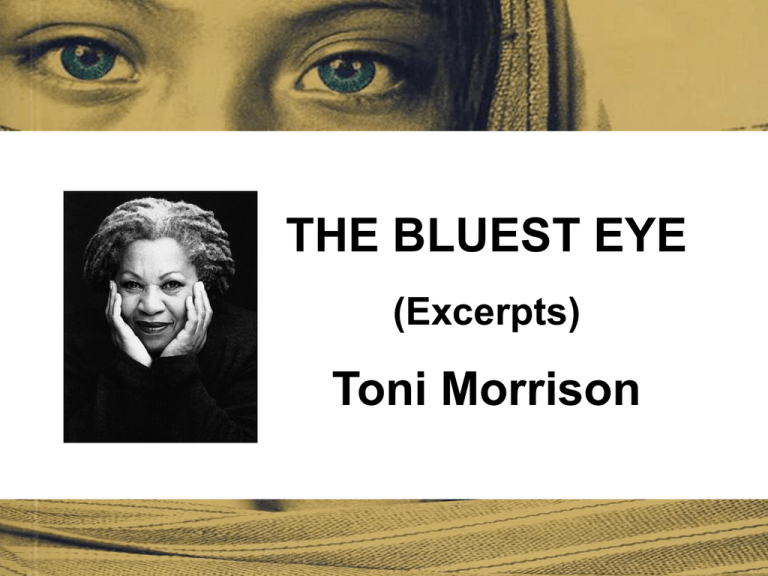
THE BLUEST EYE
(Excerpts)
Toni Morrison
Background Information
About the author
Toni Morrison (born in Lorain, Ohio on February 18, 1931) is a Nobel Prize and
Pulitzer Prize-winning American novelist, editor, and professor. Her novels are
known for their epic themes, vivid dialogue, and richly detailed black characters.
Novels
Beloved (1987)
The Bluest Eye (1970)
Jazz (1992)
Sula (1974)
Paradise (1999)
Song of Solomon (1977) Love (2003)
Tar Baby (1981)
A Mercy (2008)
About the novel The Bluest Eye
I. The Story
The Bluest Eye is the story of eleven-yearold Pecola Breedlove--a black girl who is
regarded “ugly” by everyone, including her
parents, even herself. Her parents ignore her,
other school children bully her, and she is
raped by her drunk father and gets pregnant,
later she gives birth to a stillborn child. Finally
Pecola loses her mind and spends the rest of
her life as a mad woman believing that she has
the bluest eyes of the world and she is beautiful,
happy and all the problems are gone.
Primer Story
Here is the house. It is green and white. It has a
red door. It is very pretty. Here is the family.
Mother, Father, Dick, and Jane live in the greenand-white house. They are very happy. See Jane.
She has a red dress. She wants to play. Who will
play with Jane? The kitten goes meow-meow. The
kitten will not play. See Mother. Mother laughs.
Laugh, Mother, laugh. See Father. He is big and
strong. Father, will you play with Jane? Father is
smiling. Smile, Father, smile. See the dog. Bowwow
goes the dog. Do you want to play with Jane? See
the dog run. Run, dog, run. Look, look. Here
comes a friend. The friend will play with Jane.
They will play a good game. Play, Jane, Play.
Back Cover
"Each night Pecola prayed for
blue eyes. In her eleven years, no
one had ever noticed Pecola. But
with blue eyes, she thought,
everything would be different. She
would be so pretty that her parents
would stop fighting. Her father
would stop drinking. Her brother
would stop running away. If only
she could be beautiful. If only
people would look at her."
II. Theme
Source of the tragedy: black people accepted and internalized white
values and developed self-contempt and self-hatred for themselves or other
black people, making some of their own people victims and scapegoats.
The impact of mainstream white culture upon black people, which make
them victim of the circumstances.
"Beauty, love … actually, I think, all the time that I write, I’m writing
about love or its absence.…I thought in The Bluest Eye, that I was writing
about beauty, miracles, and self-images, about the way in which people can
hurt each other, about whether or not one is beautiful."
-------Toni Morrison
Useful Links:
http://www.randomhouse.com/features/morrison/index.html
http://www.gradesaver.com/bluest-eye/
http://lz.book.sohu.com/serialize-id-4131.html
Detailed Analysis of the Text
Structure
Part 1 (Paras.1-9) About those brown girls.
I. (1-5) General analysis of these brown girls
II. (6-9) Distorted personality because of their hiding their nature.
Part 2 (Paras. 10-53) What happens to Pecola in the house of such
a brown girl.
Detailed Analysis of the Text
Discourse analysis (Para 1-5)
Question: There is a central idea in each of the five
paragraphs. Can you point them out?
In paragraph 1, the author refers to a character type resulting from the
brown girls’ hometowns.
In paragraph 2, the author gives a general picture of who these brown girls
are, what they are like, and how they live.
In paragraph 3, the author shows the brown girls’ school education.
In paragraph 4, the author shows that the brown girls have not only
assimilated the way of life but also the ideology of the white middle-class.
In paragraph 5, the author shows the brown girls’ skills in keeping a
household.
Para. 1
Questions on content:
1.Who are “they” described in Paragraph 1 to 5?
"They" refer to a type of black people here: brown-skinned people, they have brown
skins, which are lighter than those of the normal black people.
2. Paraphrase “a white butterfly glance off a fence with a torn wing”
glance off: hit a surface at an angle and move away from it in another direction
Here the author uses a butterfly with a torn wing as a metaphor, meaning fragile beauty.
3. How do you understand "The sounds of these places in their mouths make you
think of love."
Para. 2
In this paragraph the author gives a general picture of who these brown girls are,
what they are like, and how they live. The descriptions show that they are
thoroughly assimilated into the white, middle-class way of life.
Read the first eight lines and pay attention to the following expressions.
1.The sound of it opens the windows of a room like the first four notes of a hymn.
2.sly affection
3.But these girls soak up the juice of their home towns, and it never leaves them.
4.They have the eyes of people who can tell what time it is by the color of the sky.
Para. 2
5. Next several sentences tell us that in the black neighborhoods, everyone has a
good and steady job, things are arranged for leisure, and many plants are grown
to make a pretty house.Read the part "Such girls live in quiet black neighborhoods
where everybody is gainfully employed. …and NO ICE on the fourth."and pay
attention to the following expressions.
porch swings hanging from chains: 用铁链悬挂的游廊摇椅
Rooster Comb鸡冠花
Bleeding heart荷包牡丹
Mother-in-law Tongue岳母舌
6. What is the cardboard sign like? What is the use of the sign?
Para. 2
Read the rest lines of this paragraph, and answer the following questions.
7. "These particular brown girls are not like some of their sisters." How are they
different?
8. The following part talks about how these brown girls try to imitate the middleclass whites and to make themselves clean and pretty according the standards of
beauty set by the dominant culture.
9. Why did they always sing the second soprano? Why they call sex "nookey"?
Para. 3&4
In these two paragraphs the author shows that these brown girls have not only
assimilated the way of life but also the ideology of the white bourgeoisie/middle-class.
They receive more formal school education than their poorer sisters, as a result they are
more alienated from their black cultural heritage and try to “get rid of the funkiness of
nature, the funkiness of the wide range of human emotion”.
Land-grant colleges:政府拨地建造的学校
Normal school:
师范学院
Home economics: 家政
So what is the meaning of "funkiness"?
Note 12
“Funky” has several meanings. It is associated with a jazz style having an earthy
quality derived from early blues or gospel music. It may mean unconventional,
eccentric, offbeat, etc.. It also may mean very emotional, informal, relaxed, casual, etc..
Funk is associated with spontaneity and sensuality.
Para. 3&4
Para4 shows how the brown girls try hard to repress their emotions and passions.
Some vivid verbs: erupt- wipe it away
crust- dissolve it
drip, flower,cling-find it and fight it
How did they fight it?
details: laugh not too loud
enunciation not too round
behind not to sway too free
gesture not too generous
worry about their lips and the edges of their hair
Para. 6-9
What does the author tell us about the brown girl in Paragraphs 6-9?
Para.6 : The brown girl will make her home her own inviolable world against any
outsider, even against her husband. She runs the house in her own way. Although she
keeps the house clean and tidy, she does not give it any warmth.
stick by stick: little by little, by and by
stand /mount guard over: guard
A sidelong look will be enough to amoke on the back porch.
Nor do they know that she will give her body sparingly and partially.
Para.7-9: Usually she would have distorted personality. She denies herself of normal
sensual experience and therefore can only find occasional sensual delight in a cat, who
is first even to her own son.
Para. 6-9
How did she become such a distorted woman?
"When the intruder comes home..." Who is the intruder?
Her husband.
Several words to describe the cat:
settle and caress her with his eyes;
back paws struggle for footing on her breasts, forepaws cling to her shoulders;
preen, stretch, open his mouth;
writhe beneath her hand, flatten his eyes;
circle about her shanks;
soft hill of hair: hair like a soft hill
Note: “of” is used between two nouns, with the first describing the second
e.g. a tyrant of a father
that palace of a house
In rushed a giant of a French officer.
She was a mere slip of a girl.
Part 2 (Para.10-53)
I. (Paras. 10-14): About Mrs. Geraldine and her son Junior.
II. (Paras. 15-53): What happens to poor little Pecola.
Para. 10
What is the function of Paragraph 10?
This paragraph serves as a transition of the brown girls in general to focusing on one
particular brown girl– Geraldine.
Para. 11
What does a baby need to grow up healthily?
Physically needs: comfort and satiety; brushed, bathed,oiled and shod.
Emotional needs: talk to him, coo to him, indulge him in kissing bouts, let them cry.
What is Junior's feeling towards his mother? Do you think Junior also has a
distorted personality?
Para. 12
1.Sport Facilities at school campus:
swing:
slide: smooth slope, track or chute down on which children can play at sliding
Monkey bars: an arrangement of horizontal and vertical bars erected as in a
playground for children to climb on, swing from, etc.
seesaw: long plank, balanced on a center support, and with a person sitting at each
end, which can rise and fall alternately
2.ways to address a black:Nigger, Negro, the black, African-American
3."His hair was cutas clost to his scalp as possible to avoid any suggestion of wool,
the part was etched into his hair by the barbor."
to avoid any suggestion of wool:避免显出像羊毛般卷曲的样子
part: n.发缝
etch: to make a drawing, design, etc. on mental, glass, etc. engrave; here used
metaphorically to refer to the action of the barber’s scissors
Para. 13
Question: What kind of boy Junior used to be? What change has taken place in
Junior in his relationship with other boys? What has caused such a change in him?
Several details about the former Junior:
He liked the game King of the Mountain: a game in which each player attempts to climb to
the top of a mound of earth and to prevent all others from pushing or pulling his/her off the top.
…smell their wild blackness…:闻他们黑人身上的野味儿…
He wanted to sit with them on curbstones and compare the sharpness of jackknives, the
distance and arcs of spitting.
Present Junior: play only with white children who are good enough for him;
bully girls; lie; throw gravel at others
pick on (infml.): to tease or bully; choose for punishment, blame, or an unpleasant job, esp.
repeatedly and unfairly
e.g. Why are you always picking on me?
beat him witless: beat him dead
Para. 15-34
Expressions:
when the mood struck him(para.15)
at recess(para.15): a pause from doing something (as work)/ break.
smile his encouragement(para.33)
Questions:
1.How to explain Junior’s “alternately bored and frightened at home”?
He is frightened of what?
2. Why Pecola kept her head down? Why no one ever played with her?
Para. 35
Main content: When Pecola stepped into the house, she was amazed at its beauty,
suddenly Junior threw a cat in her face.
Q: What’s the symbolic meaning of the description of the Bible and the
picture of Jesus Christ?
A: The Bible, containing all the important teachings of Jesus Christ, is a symbol of
Christian faith. However, the big red-and-gold Bible placed on the most conspicuous
place in the room had become a showpiece. For the same purpose of showing off, a
color picture of Jesus Christ hung on a wall with pretty paper flowers. It is easy to
see the irony here because Jesus Christ teaches love of one another, love of your
neighbors, but what Junior and his mother did to Pecola later before the picture of
Jesus is just the opposite. They have nothing but hatred for this little black girl.
Para. 36-39
This part shows how Junior took delight in torturing Pecola.
Description
Junior was laughing and running around the room clutching his stomach delightedly.(para.36)
"You can't get out. You are my prisoner,"he said. His eyes were merry but hard..(para.37)
Pecola's banging on the door increased his gasping, high-pitched laughter.(para.39)
Para. 40-44
Can you retell this part in your own words?
Para. 45-48
1. Translate the following sentences describing Pecola.
She looked at Pecola. Saw the dirty torn dress, the plaits sticking out on her head, hair
matted where the plaits had come undone, the muddy shoes with the wad of gum peeping out
from between the cheap soles, the soiled socks, one of which had been walked down into the heel
of the shoe.
她打量着佩克拉,看见她穿者又脏又破的裙子,头上扎着小辫子,有几根已经散开了,
头发乱糟糟的,鞋子上沾满了泥土,廉价的鞋底中露出一团胶块,袜子也是脏兮兮的,其
中一只还在走路时滑到了鞋的后跟。
Para. 48
2.In the sentence“she had seen this little girl all of her life”, does“this little girl” refer to
Pecola specifically?
3. Paraphrase: "Eyes that questioned nothing and asked everything."
4. Paraphrase:"The end of the world lay in their eyes, and the beginning, and all the waste in
between."
Para. 49
In this paragraph, Geraldine listed things these black girls did to prove that they had no
manners and were not nice and quiet like brown girls.
Pay attention to the following sentences:
The girls grew up knowing nothing of girdles, and the boys announced their manhood by
turning the bills of their caps backward.
Grass wouldn't grow where they lived.Flowers died. Shades fell down. Tin cans and tires
blossomed where they lived.
Para. 50-53 The end of the story.
1. "You nasty little black bitch. Get out of my house."(para.51)
----very strong swearword. What does it show?
2. "Pecola backed out of the room, staring at the pretty milk-brown lady in the pretty gold-andgreen house who was talking to her through the cat's fur."(para.52)
This picture is created in contrast with the picture depicted in the primer at the beginning of
the novel, and an ironic effect is achieved.
In the pretty and green-and-white house, Jane lives happily with her mother and father, a kitten
and a dog. The lovely kitten goes meow meow. A friend comes and will play with Jane.
3. ...Jesus looking down at her with sad and unsurpriesd eyes...(para.52)
4. Do you think the concluding paragraph is loaded with meanings into the description of how
Pecola walked away from the house?

